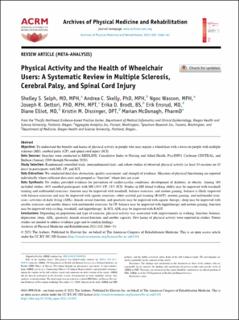| dc.identifier.citation | Physical Activity and the Health of Wheelchair Users: A Systematic Review in Multiple Sclerosis, Cerebral Palsy, and Spinal Cord Injury Selph, Shelley S. et al. Archives of Physical Medicine and Rehabilitation, Volume 102, Issue 12, 2464 - 2481.e33 | en_US |
| dc.description.abstract | Objective
To understand the benefits and harms of physical activity in people who may require a wheelchair with a focus on people with multiple sclerosis (MS), cerebral palsy (CP), and spinal cord injury (SCI).
Data Sources
Searches were conducted in MEDLINE, Cumulative Index to Nursing and Allied Health, PsycINFO, Cochrane CENTRAL, and Embase (January 2008 through November 2020).
Study Selection
Randomized controlled trials, nonrandomized trials, and cohort studies of observed physical activity (at least 10 sessions on 10 days) in participants with MS, CP, and SCI.
Data Extraction
We conducted dual data abstraction, quality assessment, and strength of evidence. Measures of physical functioning are reported individually where sufficient data exist and grouped as “function” where data are scant.
Data Synthesis
No studies provided evidence for prevention of cardiovascular conditions, development of diabetes, or obesity. Among 168 included studies, 44% enrolled participants with MS (38% CP, 18% SCI). Studies in MS found walking ability may be improved with treadmill training and multimodal exercises; function may be improved with treadmill, balance exercises, and motion gaming; balance is likely improved with balance exercises and may be improved with aquatic exercises, robot-assisted gait training (RAGT), motion gaming, and multimodal exercises; activities of daily living (ADL), female sexual function, and spasticity may be improved with aquatic therapy; sleep may be improved with aerobic exercises and aerobic fitness with multimodal exercises. In CP, balance may be improved with hippotherapy and motion gaming; function may be improved with cycling, treadmill, and hippotherapy. In SCI, ADL may be improved with RAGT.
Conclusions
Depending on population and type of exercise, physical activity was associated with improvements in walking, function, balance, depression, sleep, ADL, spasticity, female sexual function, and aerobic capacity. Few harms of physical activity were reported in studies. Future studies are needed to address evidence gaps and to confirm findings. | en_US |

